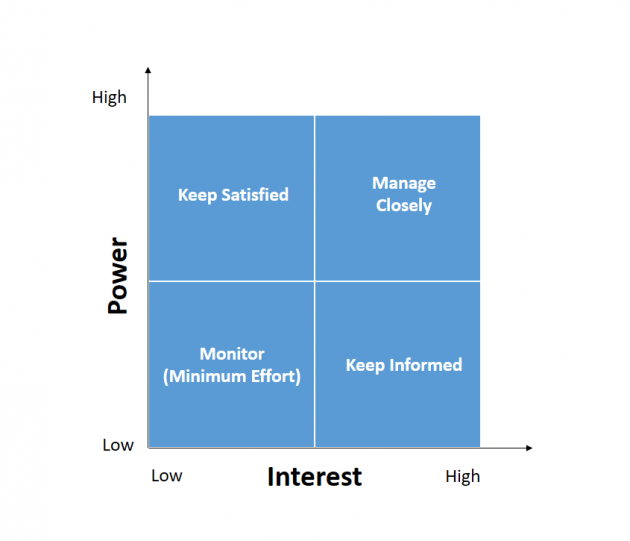Stakeholder management in a project can be vital for the very survival of the project.
Therefore, including everyone who is interested in the project, as well as all those that can influence the project, is a fundamental step for an optimal start.
CONTENT INDEX
Stakeholders identification
Before starting a new project, each project manager should take the necessary time to identify all the stakeholders.
As a first step, it is therefore necessary to analyze the stakeholders, is to conduct an analysis of the stakeholders, or an evaluation of the key participants in a project.
Subsequently, it is necessary to identify their individual characteristics and interests, define the roles and level of participation and determine if there are conflicts of interest between stakeholders.
Furthermore, it is necessary to evaluate how the project will influence them and their needs.
After that, we move on to assess the influence of a stakeholder, ie the degree to which the interested parties can influence the project.
The more a stakeholder is influential, the more the project manager will need his support and consent.
The project manager, knowing what each stakeholder expects from the project, will be able to adjust the level of support accordingly.
How should a project stakeholder be managed?
To make everything even more complicated, there may be many stakeholders, with different characteristics.
The answer in this case is simple. You have to treat them in the same way as you treat any other task in the to-do list: ie classifying by priority.
During a project, one stakeholder may be more influential than another, while some stakeholders may require more attention than others.
With stakeholder management, we mean to create a positive relationship with the stakeholders, meeting their expectations and the goals they agreed upon at the beginning of the project.
However, this relationship is not granted a priori, but must be earned.
The advantages of good stakeholder management
A positive relationship with the stakeholders can be built through proactive communication and listening to their needs.
One way to do this is to interview the project’s stakeholders, of course not all of them, but certainly the most important.
It could be the case that you need to speak with experts to get the basic information you need regarding particular groups.
This in order to get the most out of individual conversations with stakeholders, without unnecessary or superfluous words.
When talking to a stakeholder, it is necessary to understand his project expectations.
In case of doubts or when a concept has not been completely understood, it is necessary to ask for clarifications.
Moreover, each stakeholder can have a different idea of what “project success” means and, discovering it only at the end of the project, is a certain failure.
A project manager must collect this information in advance and include it in the objectives.
This would give him the guarantee that all the stakeholders support the final results.
Stakeholder management and the passive communication failure
Another key concept is to maintain the stakeholders involved and not use just a passive communication.
Ask for their contribution, learn to know them better, maybe during a coffee break, a lunch or a fast meeting, in short, make them participate; this can change everything.
Stakeholders must also be regularly updated on the project status.
Every day can be exaggerated, every month is not enough, unless this schedule is agreed.
Usually a weekly update is the best strategy.
Regular communication is always appreciated and can even soften the situation when there are bad news to share.
These are the bases in order to build strong relationships with stakeholders.

But as in any relationship, there are subtleties that every successful project manager should understand.
For example, a project manager should learn to recognize differences and “adjust” behavior to better relate to different types of stakeholders.
How to relate with different types of stakeholders
By conducting a stakeholder analysis, project managers can gather sufficient information on which to build solid relationships, regardless of the differences between them.
For example, the needs and requirements of a marketing director will be different from those of a chief information officer.
Therefore, the commitment of the project manager with each one must be different.
All project stakeholders will have different interests.
Some of them will be more interested in the ROI of the project, others will want to improve operations, others will want to increase market share or production, etc.
Keeping in mind the expectations and needs of each one of them is crucial during every conversation, relation or e-mail, regardless of how casual or formal the communication may be.
Regardless of the needs or desires of a stakeholder, all interested parties will respect a project manager who:
- is always honest, even when he tells them something they do not want to hear;
- becomes the „owner“ of the project;
- is reliable;
- is firm in his decisions;
- takes his responsability for errors.
Achieving the goals of a project requires a focused and well-organized project manager able to engage with a proactive team and able to get the support of all the interested parties.
Building solid and trustful relationships with stakeholders from the start can make the difference between success and failure of the project.
Tools to help stakeholder management
There are many “decelerating” factors in a project, the lack of support from stakeholders is one of those.
How do you make sure you have their support?
As previously mentioned, the key lies in identifying who the stakeholders are and what influence they have on the project.
Just because they are important in the organization in general does not necessarily mean that they are important for the project.
Just because they think they are important does not mean they really are.
Just because they do not think they have to be involved does not mean they do not have to be.
Not all stakeholders are the same, so understanding how to deal with each of them is essential.
To help you identify them, you can use this simple matrix:

- People with a lot of power and a lot of interest in the project (manage closely): these people have a great interest in the project and they have the power to help to successfully complete it. It is therefore essential to fully involve these stakeholders, to pay attention to their inputs, to implement their ideas when possible and to ensure that they are always satisfied. You have to follow them closely.
- People with a lot of power, but less interest in the project (keep satisfied): these people have little involvement or personal interest in the project, but they are very powerful. Surely it is better to keep them satisfied, but you must disturb them as little as possible. They can be involved in the most important decisions, but in general you must “only” make sure they understand how the project will have a positive impact on them.
- People with little power, but a lot of interest in the project (keep informed): these people have a real passion for the project, but they have little influence on it. The best strategy is to keep them informed about any important developments. The project, in most cases, can have a direct impact on this type of stakeholder, so they are usually more than willing to help when they can.
- People with little power and little interest in the project (monitor- minum effort): these represent the most apathetic stakeholders, the least interested in the project and which, in general, require little time and attention. If they are not disturbed or no damage to them is caused, a project manager will hardly have to deal with it.
Ensuring that stakeholders are listened and appreciated will certainly increase trust and support.
Building positive relationships and understanding motivations takes time and effort, but in the long run it will make the whole work easier.
Projects are more successful when everyone is on board and rowing in the same direction!
Have you ever dealt with a difficult project stakeholder?
What did you do to improve the situation?
Tell us about your experience.




